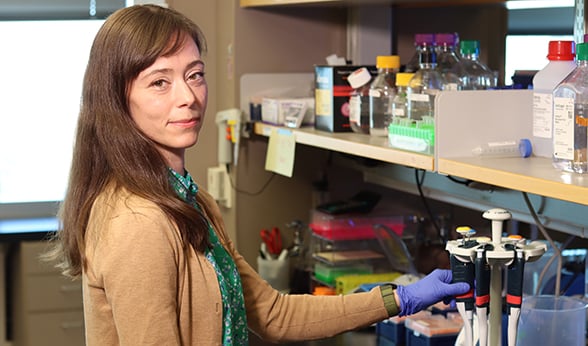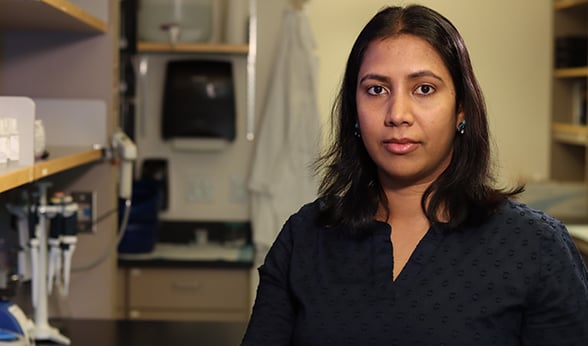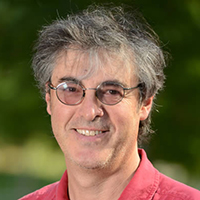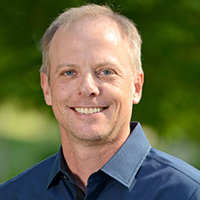A star took center stage at the University of Colorado Anschutz Medical Campus on April 26, where the award-winning “guest” was presented by some of its greatest fans to a roomful of many new admirers.
RNA – and its acting director, messenger RNA (mRNA) – was the featured celebrity of the show in the new Donald M. Elliman Conference Center in the Anschutz Health Sciences Building. The 2022 premiere of “Transforming Healthcare” revealed “The Promise (and Proof) of RNA Research” through the lens of its most talented crewmembers.
|
What: “Transforming Healthcare: The Promise (and Proof) of RNA Research” Why: An educational community event honoring patients, friends and donors Special guest: RNA and its greatest fan club: The RNA Bioscience Initiative. RBI has nearly tripled in size since its launch in 2016, attracting star researchers and energizing RNA research in the area. Emcee: Peter Buttrick, MD, senior associate dean for academic affairs, who pointed out the most powerful letters in the “A, C, G, U” RNA alphabet are: CU. CU Anschutz Chancellor Donald Elliman welcomed the audience, which included donors. “We couldn’t have done what we are doing today without supporters like you.” CU School of Medicine Dean John J. Reilly Jr. also welcomed guests via video. Reilly’s office funded RBI with $20 million in 2016, launching the university’s own cutting-edge research hub. |
“I am excited to be able to introduce you this evening to one of the brightest stars in life’s galaxy: the very talented, the very beautiful molecule of RNA,” said David Bentley, PhD, co-founder and co-director of the University of Colorado School of Medicine RNA Bioscience Initiative (RBI).
“We at RBI are very lucky people,” Bentley said of the campus hub for innovative RNA research since 2016. “We get to spend our time studying the biology of this marvelous molecule, whose abilities seem to never cease astounding us.”
Bentley and his RBI colleagues, four of whom joined him in the lecture series’ speaker lineup for the community research showcase, have focused their careers on unlocking the secret talents of RNA, or ribonucleic acid. Yet much of the world was recently awakened to the molecule’s abilities, when a rapidly produced mRNA-based vaccine came to the rescue early in the COVID-19 pandemic.
‘Operating not in the spotlight’
Like a star ballerina who outshines her partner, a spectacular example of translational research resulted in the breakthrough vaccines, Bentley said. But like a ballerina’s partner, basic research provided the foundation for the molecule’s stunning performance.
“That is the role of basic research, often operating not in the spotlight but serving an essential purpose and role in enabling important advances in medicine,” Bentley said. Many of those advancements have happened at CU, Bentley said.
In 1989, CU Boulder researcher Tom Cech, PhD, along with CU alumnus and Yale Professor Sidney Altman, PhD, “rocked” the foundations of biochemistry with their Nobel prize-winning discovery that the molecule could catalyze chemical reactions, Bentley said. The “staggering achievement” informs the life-changing work of his “dream team” of RBI researchers on the CU Anschutz Medical Campus today, he said.
Painstaking, daunting but thrilling
“In order to meet the pandemics of the past and the global outbreaks of the future, we need to know more about these viruses,” said Jeffrey Kieft, PhD, vice chair of biochemistry and molecular genetics and senior member of RBI. “One important way to learn about them is to study their RNA.”
Renowned for his work in structural biology, Kieft and his RBI colleagues peer deeply into RNA — linear molecules found within all cells that serve as a messenger of genetic information and perform myriad other tasks — to discover how they perform their multiple functions. His work, he said, is both critical and challenging.
Just as a paleontologist can tell by the structure of a dinosaur’s teeth if the creature was a meat or a plant eater, a researcher can gain powerful knowledge of RNA functions by learning its structure, Kieft said. But that structure is versatile and dictated by countless sequences of its four-letter alphabet (A, C, G and U).
“So we need to see thousands more RNA sequences to understand the basic rules,” Kieft said, noting that RNA can be both a causative agent of disease and a key to therapy.
Critical, complex and costly
It doesn’t matter where the viral particles his team studies come from: Viruses affect everything from sea slugs and oak trees to elephants and ants, he said. And it doesn’t matter if the researchers study home-team good RNA (which provides blueprints for building the body’s critical proteins) or visiting-team viral RNA.
“Both have to play on the same field and by the same rules,” Kieft said. “We learn how RNA in general works. Once we learn those fundamental rules, we can apply them to things like understanding cancer, diabetes or neurodevelopmental diseases.”
Basic RNA research is both complex and costly and dependent largely upon philanthropic gifts, as it often generates less grant money than its translational research cousin, Kieft said. A leap in technology in the past three to five years has been leading to “profound discoveries,” he said, noting the importance of the massive cryo-electron microscope his team uses as an example.
CU Anschutz leading the way
“I think there are two places in the world right now that are at the cutting-edge of developing the methods to apply these sorts of technologies to RNA structure research,” Kieft said. “One of them is Stanford University, and one of them is the University of Colorado Anschutz Medical Campus.”
He and his basic research colleagues are curious creatures motivated by the thrill of discovery, Kieft said, using his team’s experience with the mosquito-borne Zika virus as an example. “We started studying this about a year before the global outbreak of Zika. We were motivated purely by curiosity. We had no idea it would be a global health threat in a year.”
Now, in collaboration with other researchers on campus, Kieft’s team is developing a vaccine platform against Zika virus and other mosquito-borne viruses. “We’ve engineered this technology that is patented in the U.S. and overseas. Hopefully, that technology will be the basis for all kinds of new therapies.”
One mutation: debilitating result
While the Zika and COVID-causing SARS CoV-2 stories illustrate the power of basic research, the breadth of the RBI’s work far exceeds vital vaccines, said core member Olivia Rissland, DPhil. “To realize this huge potential, we need to understand the syntax,” or the A, C, G, U-based language that RNA uses to relay its critical instructions, she said.
Whether likening it to a recipe, as Rissland did, or a 7,500-piece LEGO spaceship instruction booklet, as Jay Hesselberth, PhD, did in describing RNA’s job, misreading a step can lead to disaster.
A single mutation can cause the cells to misread the instructions, producing errors that scientists suspect account for half of all human genetic disorders,” said Hesselberth, co-director of RBI, who focuses on RNA damage and repair.
Think of each cell as a factory, said RBI core member Sujatha Jagannathan, PhD. RNA takes the genetic instructions from the command center (nucleus) and then sends a copy of those instructions to the factory floor (cytoplasm) for production. “Now think of the scale,” with 2 million proteins produced every minute, she said. “For a process like that to happen accurately, you need quality control.”
Jagannathan studies facioscapulohumeral muscular dystrophy (FSHD), in which muscle cells cannot conduct quality control, resulting in production of toxic proteins that destroy the muscles in the face, upper arms and shoulders.
RNA: A rising therapeutic star
Collaborating with clinicians at Children’s Hospital Colorado, RBI’s basic research pinpointing mutations has resulted in “remarkable” therapies for patients with rare diseases, Hesselberth said. The scientists have developed RNA-based drugs that seek out the mutations, or targets, and then essentially mask the mutation from the cell, he said. “In doing so, they prevent the cell from misreading the instructions.”
What also makes these drugs remarkable, he said, is the speed at which they are produced, using the drug Milasen (named after its recipient, Mila, a little girl with a neurogenerative disorder called Batten disease) as an example.
“From the discovery of the mutation that caused Mila’s disease to delivery of the drug was about 10 months,” Hesselberth said, adding their work has so far benefited about a dozen other children with rare disorders.
‘The power of basic science’
The speed factor with RNA therapies has moved science beyond the researchers’ wildest dreams, Rissland said. “With the COVID-19 vaccines, it was actually even more amazing. The first genetic sequence for the (SARS CoV-2) virus came out in January 2020. By March 2020, just two months later, Moderna was injecting humans in trials.”
“The idea for mRNA vaccines started out in the 1990s,” Bentley said. “It was a totally whacky idea that a few very dedicated creative people stuck with and proved was actually correct in the face of a lot of skepticism. After 30 years of basic research developing the crazy idea, by 2020, that technology was mature and ready to put into action just when the world was challenged with the deadly threat.”
Now, with the limitless possibilities of RNA discovery, the RBI crew has its scope pointed toward those promising breakthroughs. “That,” Kieft said, “is where the power of basic science lies.”










